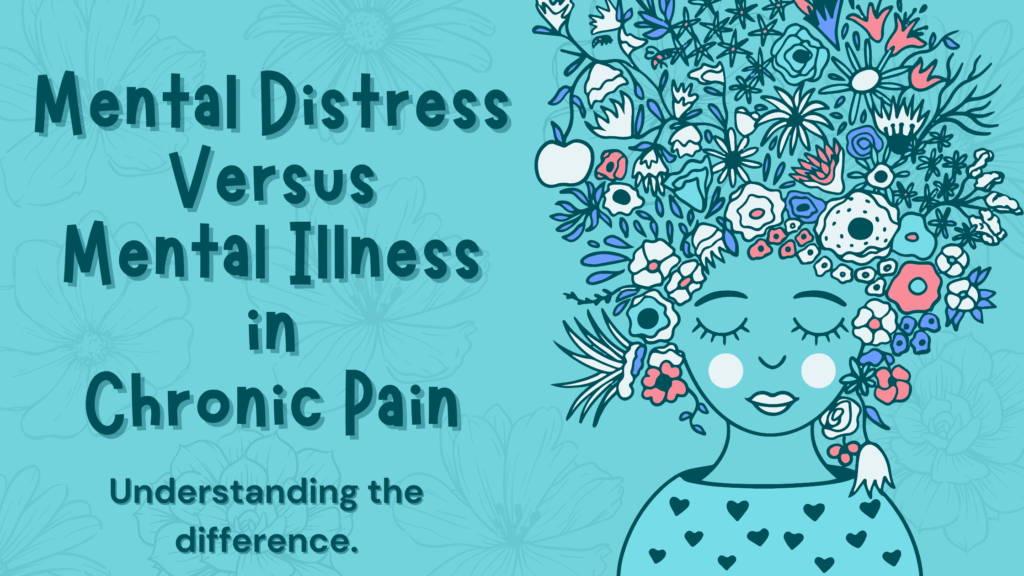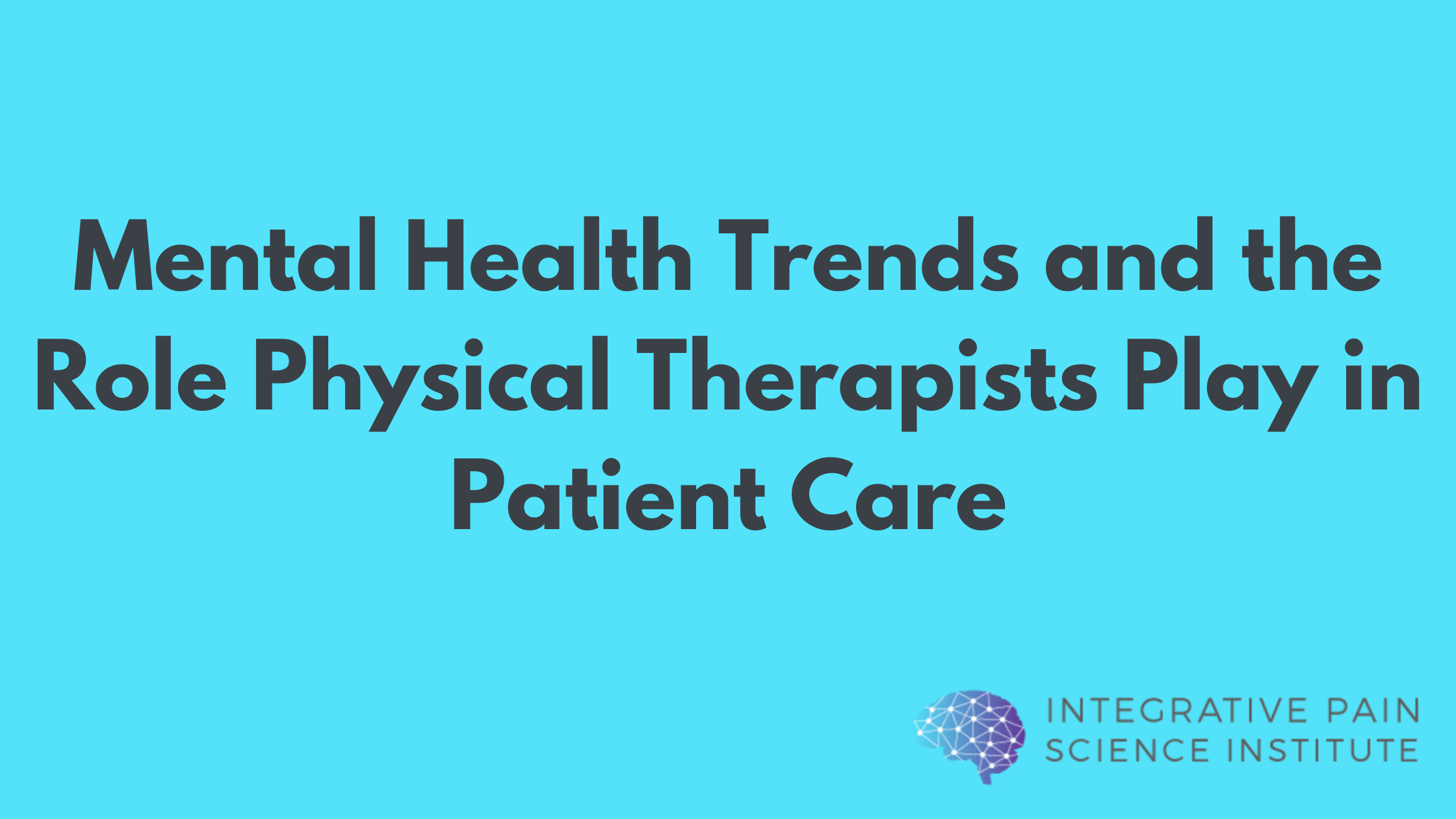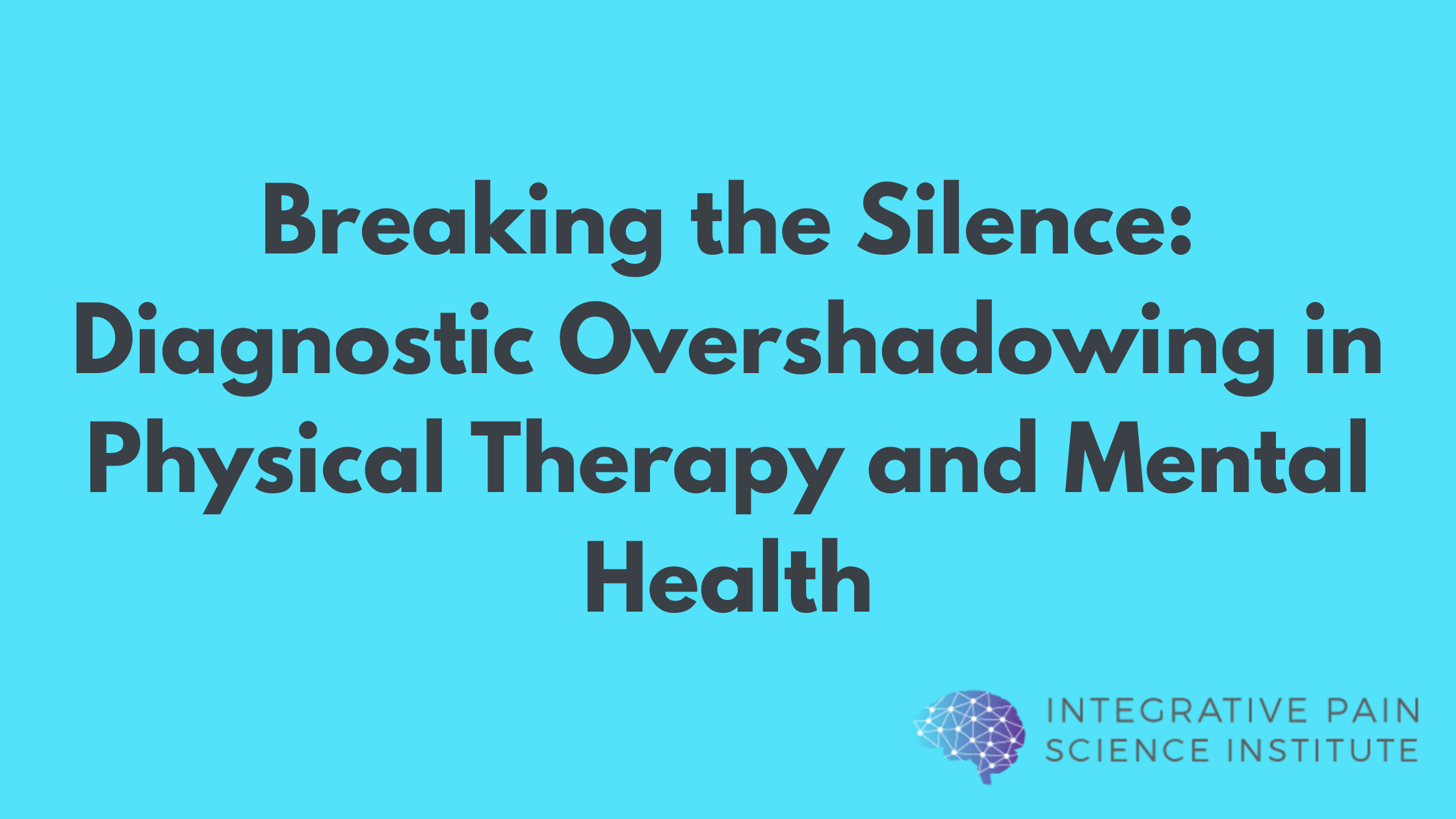
Some healthcare providers may use the two terms “mental distress” and “mental condition or mental illness” interchangeably. However, there are fundamental differences between mental distress and a mental health condition.
For physical therapists navigating the complex landscape of chronic pain management, distinguishing between mental distress and mental health conditions is paramount. This distinction is not just crucial for devising appropriate treatment strategies but also for fostering an environment that supports whole-person pain care. This blog post aims to provide physical therapists with a foundational understanding of these concepts, offering practical advice on assessment, intervention, and the referral process.
Understand the Distinction between Mental Distress Versus a Mental Health Conditions
Mental distress in the context of chronic pain refers to temporary emotional discomfort or stress that arises as a direct response to pain. It is characterized by feelings of frustration, sadness, or anxiety that are usually proportional to the situation. This may also include psychological and emotional symptoms that physical therapists are well aware of such as pain catastrophizing, kinesiophobia, fear-avoidance beliefs, and pain-related anxiety, a specific type of anxiety. If a patient’s mild to moderate mental health symptoms are effectively managed through interventions within the scope of physical therapy—such as pain literacy, mindfulness, stress reduction techniques, and motivational interviewing—and these interventions contribute to positive outcomes in both pain management and mental well-being, a referral is not necessary. Physical therapists should reassess every 4-weeks with the use of validated self-report measures. The take-home message is that symptoms of mental distress are generally temporary or state-specific symptoms. These symptoms often significantly reduce or completely resolve adequate psychologically informed physical therapy.
Symptoms and Assessment of Mental Distress
Common symptoms of mental distress in those with chronic pain include fear, increased irritability, temporary mood swings, sleep disturbances, and heightened stress. To assess these symptoms, physical therapists can utilize evidence-based self-report measures. Measures should include both factors related to pain vulnerability and pain resilience. Pain vulnerability leads to poor outcomes in pain management. Pain resilience promotes beneficial outcomes and/or buffers vulnerability toward negative outcomes. Both vulnerability and resilience should be assessed and addressed in whole-person pain care.
Vulnerability Measures Include:
- Fear-Avoidance Beliefs Questionnaire
- Tampa Scale of Kinesiophobia
- Pain Catastrophizing Scale
- State-Trait Anxiety Inventory
- State-Trait Anger Expression Inventory
- Patient Health Questionnaire-9
- Pain Anxiety Symptoms Scale
Resilience Measures Include:
- Pain Self-Efficacy Questionnaire,
- Self-Efficacy for Rehabilitation
- Chronic Pain Acceptance Questionnaire
- Pain Resilience Scale
These tools provide a quantitative measure of mental distress, also known as yellow flags, and help physical therapists identify patients who may benefit from targeted interventions. These can be easily screened for using the Optimal Screening for Prediction of Referral Outcomes-Yellow Flag (OSPRO-YF). Helping a person problem-solve and providing supportive pain self-management helps to build resilience in the face of pain so that people can continue functioning and potentially fully recover.
Mental Health Conditions Common in Chronic Pain
Mental health conditions involve more persistent and severe psychological symptoms that can affect an individual’s ability to function separate from a pain condition. These conditions may be exacerbated by chronic pain but often have a broader range of causes and require more specialized treatment. The more common mental health conditions seen in pain management are bipolar disorder, borderline personality disorder, major depressive disorder/clinical depression, generalized anxiety disorder, and acute PTSD. Substance use disorders (e.g. alcohol, opioids) are also common in people being treated for chronic pain.
Patients expressing thoughts of self-harm or suicidal ideation need immediate referral to mental health services. These are critical conditions that require urgent and specialized mental health intervention. Physical therapists should be familiar with 988 Suicide and Crisis Lifeline as well as brief suicide risk screening tools to use during the initial evaluation. One example is the Ask Suicide Screening Questions.
The above is not a complete list of mental health conditions. Mental health conditions exist across the lifespan and may be specific to physical therapy specialty practice areas (e.g. pediatrics and ADHD). Typically, these conditions are not diagnoses a physical therapist can make independently. It requires collaboration with a mental health provider for the evaluation, assessment, and ongoing management of the patient’s care. These patients, if not already, may need to be supported with psychopharmacology and/or counseling. At the initial evaluation physical therapists should take an appropriate past medical, current medication, and psychological history. This information may point to a mental condition that is currently being managed with medication and/or counseling. This would open a door to interprofessional conversation and a plan of care. It can also open a conversation as to what type of care the patient is currently receiving in addition to physical therapy.
People with chronic pain may be more susceptible to conditions like depression, anxiety disorders, and post-traumatic stress disorder (PTSD). To assess these conditions, evidence-based measures include:
- The Beck Depression Inventory (BDI) for depression.
- The Generalized Anxiety Disorder-7 (GAD-7) for anxiety.
- The PTSD Checklist for DSM-5 (PCL-5) for PTSD.
These assessments can help identify individuals who require a referral to mental health professionals for further evaluation and treatment.
Mental Health Exists on a Continuum
If you are still confused about the difference between mental distress and a mental health condition, consider that mental health exists on a continuum. It is a dynamic changing state that can deteriorate or improve based on a myriad of external and internal influences. This video provides a good overview.
How to Reduce Pain-Related Mental Distress: Tools and Strategies
Physical therapists can play a crucial role in reducing mental distress through various strategies. The best evidence and clinical practice guidelines recommend physical therapists routinely use these strategies to reduce mental distress commonly seen in people with pain conditions. They include:
Pain Education: Educating patients about the nature of chronic pain can demystify their experience and reduce fear. Simple explanations about how chronic pain affects the body and mind can empower patients.
Mindfulness: Introducing mindfulness techniques can help patients focus on the present, reducing stress and anxiety. Examples include guided meditation and deep breathing exercises.
Motivational Interviewing: This technique involves engaging patients in conversations that encourage them to find their motivation for change, enhancing their coping strategies.
Cognitive Behavioral Strategies: Teaching patients to recognize and challenge negative thought patterns can alter their perception of pain. For example, replacing thoughts like “I will never get better” with “Recovery takes time, and I’m making progress.”
Lifestyle interventions: promoting physical activity, sleep, nutrition, and the avoidance of risky substances.
Somatic Strategies: Incorporating gentle, body-focused practices such as progressive muscle relaxation or yoga can help reduce the physical symptoms of stress and anxiety.
How To Refer to a Mental Health Provider: When and How?
Identifying when a patient needs a referral to a mental health provider is an important skill for a physical therapist. Signs that suggest a referral include persistent psychological symptoms that interfere with daily functioning, a lack of improvement with physical therapy alone, or the patient expressing feelings of hopelessness or thoughts of self-harm.
Discussing mental health referrals can be challenging. Deciding on a referral to a mental health provider should be a collaborative process with the patient that takes into account the severity of the mental health symptoms, the impact on chronic pain management, the potential benefits of specialized treatment, and the patient’s preferences and overall well-being.
Here’s a basic script to guide physical therapists. This conversation is based on the outcomes of valid self-report measures, not the intuition of the physical therapist’s assessment of one’s mental health. Studies indicate that physical therapists may not be skilled at identifying a mental health condition without the help of validated self-report measures (listed above):
“Based on our session and your feedback, I believe you could benefit from additional support that goes beyond what we do here in physical therapy. I’ve seen many patients find it helpful to talk to another professional about their experience. This doesn’t mean our work together stops; in fact, it’s an important part of your overall care. I’m here to continue to help with reducing the pain. Together, we can work with a mental health professional so that you have more support and tools. This can be a valuable part of the work we do together. How do you feel about exploring this option?”
Some patients, fully informed of their options, may choose not to pursue additional mental health treatment at the current time. Provide people with the many benefits of mental health care and allow them to self-select the type of care they would like to receive. Respecting patient autonomy is crucial, and decisions can be revisited as needed. A physical therapist may serve as a gateway to mental health care at a later time when the patient’s readiness has changed.
Some patients may have had previous unpleasant or adverse experiences with the mental health system or an individual provider. A person with pain should not be forced to see a mental health provider. Insisting a person with pain see a mental health provider may be stigmatizing and cause additional mental distress. It may also cause a rupture in the physical therapist-patient therapeutic alliance. It may also re-traumatize someone who has had a less-than-ideal experience with the mental health system. Physical therapists may also consider that many people actively choose alternative forms of mental health care and mental well-being. This autonomy should be respected.
Many types of providers help manage a person’s mental health condition. Physical therapists should familiarize themselves with each type of provider and their unique scope of practice. Many mental health providers have similar scopes. Keep a database of providers available for referral purposes. This may include psychiatrists, psychiatric nurse practitioners, psychologists, mental health counselors, social workers, or addiction counselors.
The Importance of Continuing Physical Therapy Even in the Presence of Severe Mental Illness
It’s critical to emphasize that referral to mental health care should not result in the discontinuation of physical therapy. For many people living with pain, it takes considerable courage and risk to enter the healthcare system and develop a relationship with a physical therapist to manage their long-term pain. Patients may also feel abandoned by the physical therapist when referring to mental health. This may lead to reduced adherence to future physical therapy visits or self-discharge from physical therapy care altogether. The inappropriate referral to a mental health provider may also overwhelm an already stressed mental healthcare system that is not equipped to manage people with pain. In many parts of the United States of America, there is a mental healthcare provider shortage. Physical therapy, especially psychologically informed physical therapy, is an important part of the mental health care team and can prevent mental distress from turning into a mental health crisis.
The physical therapist’s therapeutic alliance, attunement, and attachment, combined with interventions like touch/manual therapy, exercise, pain reduction techniques, and improvements in physical disability, can significantly contribute to the alleviation of a mental health condition. Physical therapists provide a unique form of relational support that can complement mental health care, fostering an environment where patients can thrive both physically and mentally.
Conclusion
Understanding the difference between mental distress and mental health conditions is crucial for physical therapists working with patients experiencing chronic pain. By employing targeted strategies and knowing when to refer to mental health professionals, physical therapists can offer comprehensive care that addresses the multifaceted nature of pain. Most importantly, maintaining the therapeutic relationship through continued physical therapy care is essential for supporting patients’ overall well-being, underscoring the powerful role of physical therapy in the holistic management of chronic pain.
To learn more about psychologically informed physical therapy and continuing education visit www.integrativepainscienceinstitute.com or email [email protected].
Blog post written by Joe Tatta, PT, DPT
References
Lentz TA, Beneciuk JM, Bialosky JE, et al. Development of a Yellow Flag Assessment Tool for Orthopaedic Physical Therapists: Results From the Optimal Screening for Prediction of Referral and Outcome (OSPRO) Cohort [published correction appears in J Orthop Sports Phys Ther. 2016 Sep;46(9):813]. J Orthop Sports Phys Ther. 2016;46(5):327-343. doi:10.2519/jospt.2016.6487
Tatta J, Pignataro RM, Bezner JR, George SZ, Rothschild CE. PRISM-Pain Recovery and Integrative Systems Model: A Process-Based Cognitive-Behavioral Approach for Physical Therapy. Phys Ther. 2023;103(10):pzad077. doi:10.1093/ptj/pzad077
Heywood SE, Connaughton J, Kinsella R, Black S, Bicchi N, Setchell J. Physical Therapy and Mental Health: A Scoping Review. Phys Ther. 2022;102(11):pzac102. doi:10.1093/ptj/pzac102
Tatta J. A Call to Action for Mental and Behavioral Health Stakeholders: Use Physical Therapists to Close the Gap in Depression Care. Phys Ther. 2024;104(2):pzad147. doi:10.1093/ptj/pzad147
Coronado RA, Brintz CE, McKernan LC, et al. Psychologically informed physical therapy for musculoskeletal pain: current approaches, implications, and future directions from recent randomized trials. Pain Rep. 2020;5(5):e847. Published 2020 Sep 23. doi:10.1097/PR9.0000000000000847
McGrath RL, Shephard S, Parnell T, Verdon S, Pope R. Recommended approaches to assessing and managing physiotherapy clients experiencing psychological distress: a systematic mapping review. Physiother Theory Pract. Published online November 27, 2023. doi:10.1080/09593985.2023.2284823



